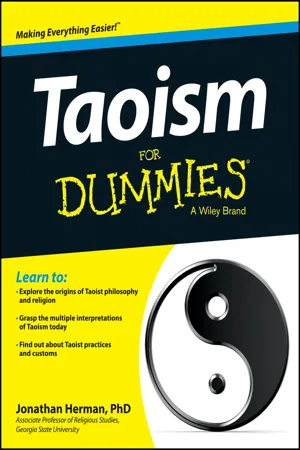Part I
Navigating the World of Taoism
In this part . . .
When you take your first steps into the world of Taoism, be prepared for some basic questions to come fast and furious. Is Taoism a philosophy or a religion? What’s the relationship between Taoism and other Chinese traditions, like Confucianism, Buddhism, or folk religion? What are the different types of Taoism? What are the most common misconceptions about Taoism? How is Taoism different from Western traditions?
Sit back, and get ready to participate in a great adventure. Or better yet, lean forward and prepare to devour every word, because Taoism can be fascinating, sophisticated, and inspiring, and it can also surprise you at every turn.
Chapter 1
An Introduction to Taoism
In This Chapter
Getting oriented to Taoism
Examining Taoist practice
Not much more than a half-century ago, many Americans had their main exposure to Chinese people and things Chinese from an exotic meal at the local Chinese restaurant, a touristy adventure in a big-city Chinatown, or even a Charlie Chan movie. Today, things have certainly changed, and the Chinese presence in America (and in the world) has come a long way from pu-pu platters, isolated ethnic enclaves, and cinematic sages speaking fortune-cookie dialogue in broken English. Today nearly 4 million Chinese people (or people of at least partial Chinese descent) live in the United States, and Chinese people may make up close to 5 percent of the Canadian population. What’s more, Chinese people now participate in pretty much every aspect of modern American culture — their contributions to schools, neighborhoods, businesses, and local communities are as important and as visible as those of any other American. And, by the way, you just may have heard somewhere that China is now an important global economic and political power, too!
So, what could possibly be a better time for picking up a few pointers on Taoism, one of China’s oldest (and most interesting) indigenous religious traditions? If you’re not Chinese, learning about Taoism could help you gain some insight into Chinese religious, philosophical, and cultural sensibilities. If you are Chinese, it’s a chance to get to know your own background and history a little better. But the funny thing is that even though Taoism has informed much of Chinese identity, it isn’t the easiest thing to find. Very few Chinese people in America identify themselves specifically as Taoists, and most communities don’t have Taoist temples. And when you do find a Taoist temple or teaching center, you may find that the staff and students consist entirely of non-Chinese people. In other words, despite the unprecedented integration of Chinese in the West, and even with the deluge of “Tao of” readers on bookstore shelves, Taoism is still pretty much a mystery to many people.
Getting the Lay of the Taoist Land
As you get oriented to Taoism, you quickly find out that there seem to be lots of different kinds of Taoism and Taoists, and that it’s often hard to figure out how any one of these “Taoisms” relates to any other. Part of this is that the Chinese aren’t always consistent in how they use the terms, and they may even apply them to people and practices that technically aren’t really Taoist. It’s especially common for people to call various nondenominational family or community customs “popular Taoism” or “folk Taoism,” just because they’re clearly not Buddhist and no one’s quite sure what category to put them in. Certainly, a big part of navigating Taoism is the process of sorting one strain from another.
Along these same lines, Taoism (like every other one of the world’s major traditions) changes over time, and not always in a linear fashion that you can chronicle with a nice, neat, century-by-century timeline. If you try to imagine a Taoist family tree, you need to be prepared for lots of gnarled branches, limbs that snap suddenly and then somehow seem to regrow again in some other location, roots that entangle with those of other trees and then become indistinguishable from each other, and oddly shaped fruits that look and taste completely different from other fruits growing on different vines on the very same tree. It is, to put it mildly, a tangled family tree.
The first step to keeping all the Taoisms straight in your mind is to develop a certain working vocabulary for classifying Taoism. This often involves examining the categories you hear most often online and in textbooks — like “philosophical Taoism” and “religious Taoism” — and then moving on to more careful and more nuanced language and divisions. You can find a discuss...



